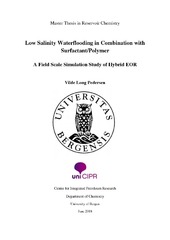Low Salinity Waterflooding in Combination with Surfactant/Polymer. A Field Scale Simulation Study of Hybrid EOR
Master thesis
Permanent lenke
https://hdl.handle.net/1956/18469Utgivelsesdato
2018-06-27Metadata
Vis full innførselSamlinger
Sammendrag
It is projected that 77% of energy consumption will originate from fossil fuels in 2040, indicating a continuous demand for crude oil [1]. Nevertheless, more than half of the hydrocarbons produced at present originate from mature fields, where the worldwide oil recovery factor averages at 20-40% of OOIP [2, 3]. Most of the sedimentary basins have already been explored, and it is becoming increasingly demanding to discover new giant fields. Consequently, there is a growing interest within the petroleum society for maximising the oil recovery from fields already discovered. Waterflooding is the most widely practiced recovery technique for pressure support and enhanced sweep efficiency purposes, and has been deployed for over a century. However, little consideration has been bestowed upon the injection-water chemistry and its effect on crude oil/brine/rock (COBR) - systems. Low salinity waterflooding is a relatively recent developed EOR-process that improves the sweep efficiency by modifying reservoir wettability and destabilize oil layers [2]. Previous studies demonstrate that the low salinity brine can be successfully combined with surfactant flooding and polymer flooding in a hybrid tertiary process. The low salinity environment is beneficial for both surfactants and polymers with regards to their physiochemical properties, as their functions are optimized in diluted water [4, 5]. Research notifies that the composite effect of the tertiary fluids may even be higher than the individual effects [6]. This thesis concerns a field scale simulation study of low salinity waterflooding in combination with surfactants and polymers in a 3-dimensional reservoir model supplied by Lundin Norway AS. The compositional reservoir simulator STARS was applied to perform the simulations. During the numerical simulations, the reservoir response towards the different tertiary fluids was examined, both when injected individually and together in a composite experiment. Compared to the reference case of continuous high salinity waterflooding, the model responded well to low salinity waterflooding in a secondary mode. Low salinity waterflooding was also successful in enhancing oil recovery in a tertiary mode, where a sensitivity study confirmed that more oil was produced for a short secondary phase and a prolonged tertiary phase. Simulation studies revealed that the surfactants were able to effectively enhance the microscopic sweep in contacted zones, but were more competent in reducing residual oil in a pre-established low salinity environment. The polymers were also effective in rising oil production beyond the capability of high salinity waterflooding. Composite low salinity surfactant/polymer –flooding simulations were conducted, where the influence of chemical adsorption and slug size on oil recovery were examined. The combination of the tertiary fluids was successful, and the process generated a higher oil recovery than the low salinity water, surfactants and polymers individually. The inevitable adsorption of surfactants and polymers onto the reservoir rock reduced the oil recovery. Nevertheless, the loss of chemicals due to adsorption did not break down the injected slug size. A sensitivity study on surfactant and polymer slug sizes revealed that the reduction from 1/3 PV to 1/6 PV only diminished the oil recovery by 1.27%. With regards to project economy, the additional oil produced by the 1/3 slug sizes is not likely to counteract the expenses of the prolonged chemical injection.
